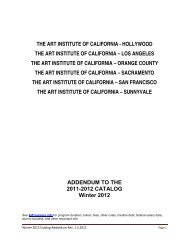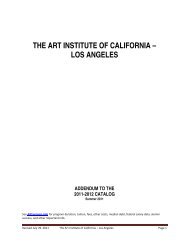Summer 2011 Issue - The Art Institutes
Summer 2011 Issue - The Art Institutes
Summer 2011 Issue - The Art Institutes
You also want an ePaper? Increase the reach of your titles
YUMPU automatically turns print PDFs into web optimized ePapers that Google loves.
It’s All Relative<br />
Our Expanding Universe: Part 2<br />
by Jeff Burkett, Mathematics & Natural Sciences Instructor<br />
P<br />
erhaps the single most important consequence of the European<br />
Renaissance was that great thinkers like Copernicus, Galileo,<br />
and Newton shattered previous notions of a geocentric universe.<br />
Science, religion, and philosophy were thrown into upheaval by<br />
the new reality that Earth was not the central object of creation. This was a<br />
mere prelude, however, to the dawn of our understanding of the true vastness<br />
of the cosmos.<br />
As early as approximately 400BC, Democritus had proposed that stars were<br />
actually distant suns, and in 1600 Giordano Bruno was burned at the stake<br />
for suggesting this heretical idea. Nevertheless, Isaac Newton, and others,<br />
soon adopted the notion. <strong>The</strong>n, in 1838, Friedrich Bessel successfully<br />
measured the first interstellar distance using the technique of trigonometric<br />
parallax 1 . He calculated the star 61 Cygni to be about 10.4 light years 2<br />
distant, an error of only about nine percent from the modern accepted value<br />
of 11.4 light years. Other measurements soon followed, and it was quickly<br />
established that Alpha Centauri was our closest stellar neighbor, 4.2 light<br />
years away. That’s roughly 24,000,000,000,000 (24 trillion) miles!<br />
Such vast distances defy human comprehension and are best understood<br />
through analogy. If the Earth were represented by a standard-size marble,<br />
the moon would be the size of a BB placed 17 inches away; the sun would<br />
be represented by a sphere 5 feet in diameter, placed 180 yards (about<br />
two football fields) from our model Earth. On this same scale, Alpha<br />
Centauri would be about 27,000 miles distant, or slightly further than the<br />
1. For an explanation of this technique, take my physics class or<br />
stop by my office.<br />
2. Note that the modern unit of light years is used here for<br />
convenience. Accurate measurements of the speed of light<br />
would not be realized until the following century.<br />
circumference of the actual Earth 3 . As incomprehensible as these distances<br />
may have seemed to early scientists, the story became even stranger.<br />
In the 1920’s, Edwin Hubble proved that not only were the billions of visible<br />
stars in our night sky, all part of the same Milky Way galaxy, but also that the<br />
Milky Way itself was only one of billions of galaxies in the universe. More<br />
astoundingly, all of these galaxies seemed to be rushing out at incredible<br />
speed from a singular point in space: the universe itself was expanding!<br />
Later, in 1949, Fred Hoyle coined the term “Big Bang” to describe this<br />
phenomenon. <strong>The</strong> term stuck, and after nearly a century of observation,<br />
experiment, and accumulated evidence, the Big Bang theory 4 remains the<br />
most complete and comprehensive explanation of the early development of<br />
the known universe.<br />
3. This model is based on that of Dr. James Pierce, Professor of Astronomy at<br />
Minnesota State University, Mankato.<br />
4. It is worth noting that the Big Bang theory deals with the behavior of the<br />
universe after its moment of inception. It is not a ‘creation’ theory and does not<br />
attempt to explain the actual causation of the universe.
















